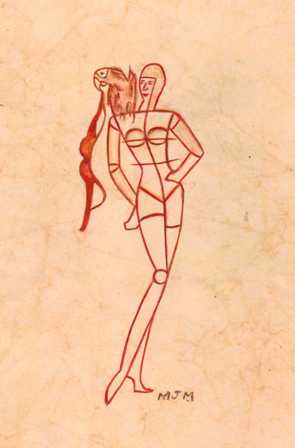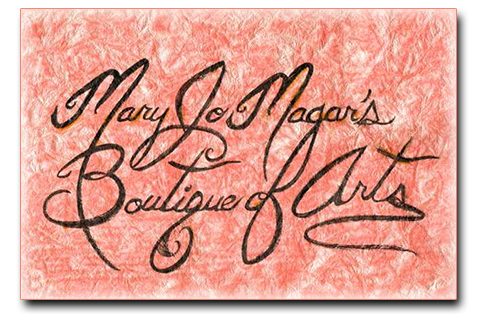Style, Jubilus, Natural Fibers, and Making the Most of Less

“Polly Want a Bra?”
painted on banana leaf paper in cochineal dye, the famous “Mexican red” derived from the female cochineal insect
Style
– Mary Jo Magar –
Clothes can make the woman; but more than that,
The woman can make her clothes: she can sew
With fabrics sown, color grown, apropos
For any time, event, or challenge pat;
For nature knows that elegance is matte,
Plain and simple, lasting, so to bestow
The woman herself with natural tableau –
Her nature own to be shown and looked at.
Few finely-made clothes are more than enough
To simplify living and one’s being
By being not the fad in fashion’s bluff,
But rather truth in comfort, wellbeing.
Eliminating excess, frills and fluff
Styles one’s self, the only style worth seeing.
Jubilus
Jubilus is a Latin term in music that derives from the Medieval era and translates as “shout of joy.” In its literal meaning, jubilus best expresses how I have always felt when removing a bra, especially at the end of a long day. The feeling is not just relief, but an actual joy in returning my body to Paradise, before the “Fall” – or the “uplift,” as the case may be. What I discovered is that jubilus also best expresses how I feel all day, any day, when not wearing a bra at all, hence, the name of this essay, honoring the joy of freedom and a return to physical paradise.
In 1969, Danish fashion historian Rudolf Kristian Albert Broby-Johansen wrote an article titled “Obituary for the Bra” in which he predicted the imminent demise of bras. Over four decades later, though the bra industry thrives, I believe that Mr. Brody-Johansen’s prediction is coming true, but very slowly, and this page of my web site represents my personal push to help hasten the bra’s greater demise. I buried my own bra five years ago, and have not since resurrected it, even once, and can honestly say that it was not even deserving of an obituary much less a funeral. I wish that I had cremated it into nonexistence, as many women did in the 1970’s.
Purportedly the two primary reasons for wearing a bra are support and modesty. Ironically, a bra is not in the least supportive of nature in terms of the overall health of a woman’s body, nor does it contribute to modesty when its function is to bring attention to the female breasts as presumably originally immodest and / or erotic. Furthermore, it is my belief and my experience that breasts are made to self-support, and bras compromise this inherency much more than contribute to it. The same principle can be observed in the wearing of glasses to aid vision: ultimately glasses weaken vision by dependency. My own breasts gained firmness, roundness, and symmetry (reversal of lopsidedness) after I stopped wearing a bra, and I “firmly” believe that ptosis is best addressed and prevented through bralessness, nutrition, and exercise: in other words, natural living.
Having mentioned exercise, I do not wish to criticise the so-called “exercise bra,” which may be necessary and is serviceably designed to do nothing more than keep breasts in place during vigorous exercise, especially public exercise; rather, the bra of my contention is the so-called “fashion bra,” which is seamlessly seamed, molded, wired, and whatever else for the purpose of shapely “support” and ostensibly immodest “modesty.”
Having tried many bras touted as “comfortable,” I can honestly state that I have never experienced one that was as comfortable as wearing no bra at all, and in fact, this same experience applies to many other accoutrements of feminine “dressing,” meaning “window dressing,” as opposed to practicality, i.e., keeping the body protected, warm, and socially presentable, which is not the same as “fashionable,” whatever “fashionable” really means.
I have come to admire individualism more than feminism for the reason that history has always given birth to women and men who gave birth to themselves without benefit of any social movements to guide or aid them or to qualify their interests, choices, or lifestyles; however, I do believe that the “patriarchal” attitude, which necessarily became the attitude of feminism in its fight against patriarchy (fire with fire) has been greatly responsible for the pains of civilization as well as the progresses. This includes horse breaking (man had to break the horse in order to transport, travel, and conquer), which, in my mind, analogizes with the evolution of fashion, particularly women’s fashion, which “broke” the woman with the harness or cinch (bra), the saddle and bridle (the constrictive, restrictive physical and psychological “weight” of certain clothing, including saddle bag-shoulder bags, which can misalign the whole body), and horse shoes (heels, which can also misalign the whole body), and oftentimes blinders to prevent sight of how unnecessary so much “fashion” is, not to mention ceremonial headdress or other decoration in order to parade on special occasions (also not to mention grooming, which is another story).
It should be noted that in recorded history, the upper classes have always been the masters and slaves of “fashion,” including bras, hairstyles, jewelry, and makeup, because the “elite” were the only ones who could afford to manipulate “dress” creatively as status, though they often could not afford to express authentic individuality at the expense of “fashion.” Moreover, to note also, all fashion, including “designer” fashion, evolved from “peasant” clothing, meaning original clothing which was not – could not – be indulgent or superfluous at all, only functional, which really is what all clothes are meant to be, even when the function is art.
Making the Most of Less
What did fashion icon Audrey Hepburn and Apple Computer founder Steve Jobs have in common? They both chose to wear the same personal uniform of a turtleneck (a mock for Jobs) and pants for the sake of convenience.
There is a lot to be said in favor of wearing a personal uniform: it is indeed convenient and eliminates those clichés “What should I wear?” and “I haven’t a thing to wear!” (despite a full closet). Most of all, a personal uniform, especially when plain and simple, which is the best kind of uniform, liberates personality by lack of detraction; that is to say, adornment, in all its forms, presents a pretty picture, but in the final analysis of a human being, character is the canvas, and the stronger the canvas, the more supremely its quality shows through to enhance adornment rather than adornment enhancing it. Interestingly, the great classical artworks were painted on natural substances such as wood or canvas of hemp, linen, or flax, which are works of art in themselves, by nature, just as people are works of art by nature, which makes adornment a socio-cultural aspect of evolution but not a necessity. It is my feeling that after centuries of learning how to adorn, the twenty-first century will teach us all how to re-learn nature, how to unadorn, how to appreciate the canvas first and then what may be displayed on it.
Audrey Hepburn (before her turtleneck-pants days) and Steve Jobs were known for their designer clothes, but really, what are designer clothes other than just clothes with someone else’s name on them, which makes them borrowed.
It is actually very easy to pattern one’s own clothes because there are only so many clothes to pattern: shirts / blouses / tunics, pants, skirts, jackets, sweaters, shawls, wraps, coats. No matter how many designers the world births, they all still have only these basics with which to work because these are the only basics to wear. Best of all, patterning one’s own clothes can achieve that elusive “perfect fit” that cannot be had “off the rack” or in “one size fits no one.”
After years of seeking a perfectly fitting outfit that would allow me to go braless, I finally settled upon making my own uniform: a smock top with straight-leg pants. The smock top allows me to go braless with modesty, a word of valuable meaning, which differs entirely from shame and which has become commercially condemned in the modern fashion industry. Personally, for my own reasons of comfort, I would not want to wear the “veil,” whether as a nun’s habit, hijab, abaya, chador, burka, tichel, or other covering, in order to define modesty according to a religious / cultural tradition (even though I find many of these coverings to be quite becoming to the feminine face and form); however, at the same time, I perceive a paradox: if we were all living in a “primitive” tribal culture where nakedness and sexuality were considered natural, which they are, and therefore commonplace, as opposed to titillating, then modesty would also be natural in the sense of absence of artifice or complexity or competition, with no relation to any necessity for bodily covering, which would only be to keep warm and protected from the elements. But we “civilized” people of today live in an overpopulated, immodest world – excessive, vainglorious, self-dangerous, and self-endangered – and therefore, all of us, especially women, need as much privacy and protection (from more than the elements) as we can secure for ourselves, including through our choices of clothing.
I have replicated my smock top-pants uniform in various weights and weaves of organic cottons, hemps, linens, and silks, so that I have a uniform for every season, though natural fibers essentially have the advantage of being multi-seasonal. I do not mind paying the unfortunate expense of authentically pure, highest-quality natural fabrics (BEWARE: there is much counterfeit on the market) because such fabrics can literally last a lifetime –and help me to last a lifetime in good health and comfort.
I encourage every woman to own few clothes of highest quality (statistically, women only wear twenty percent of their wardrobes, so why not make the twenty percent the full wardrobe?), and by highest quality I do not mean expensive (marked up), commercially “fashionable” clothes, but rather clothes that are most natural, durable, enduring in style, and personally flattering. I also encourage every woman to make her own clothes. Even if a woman cannot sew, there are always local seamstresses who need work, which results in clothes domestically, locally made – so rare anymore.
I purchase fabric from only four trusted sources:
Aurora Silk, a leader in providing the purest, rarest, and most beautiful fabrics of nature (silks, hemps, cottons), undyed or dyed with only plant dyes exclusively, which are the only historically safe dyes in existence – the concept of “low-impact” dyes is a complete fallacy.
NearSea Naturals offers an exceptional line of color-grown cotton in a vast array of unusual weaves.
Rawganique, a Canadian company, offers pure hemp exclusively.
Summerhouse Textile which offers beautiful certified eco-linens.
